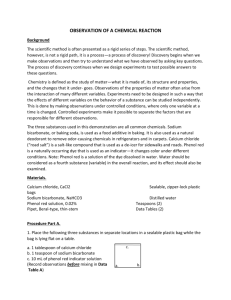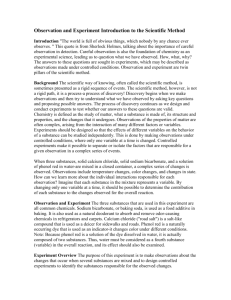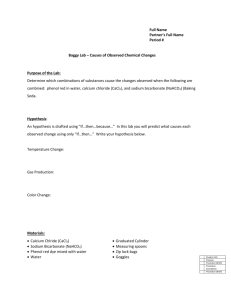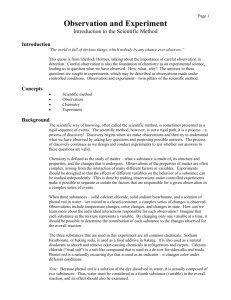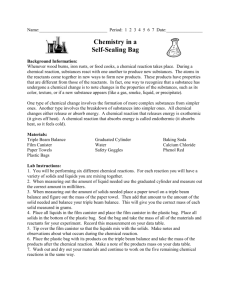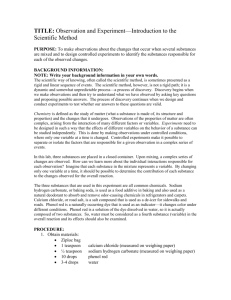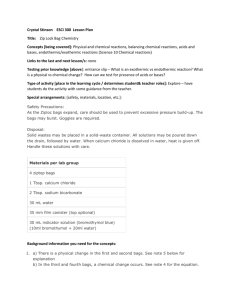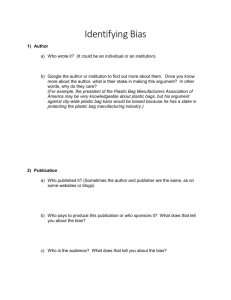Ziplock Chemistry Thermodynamics
advertisement
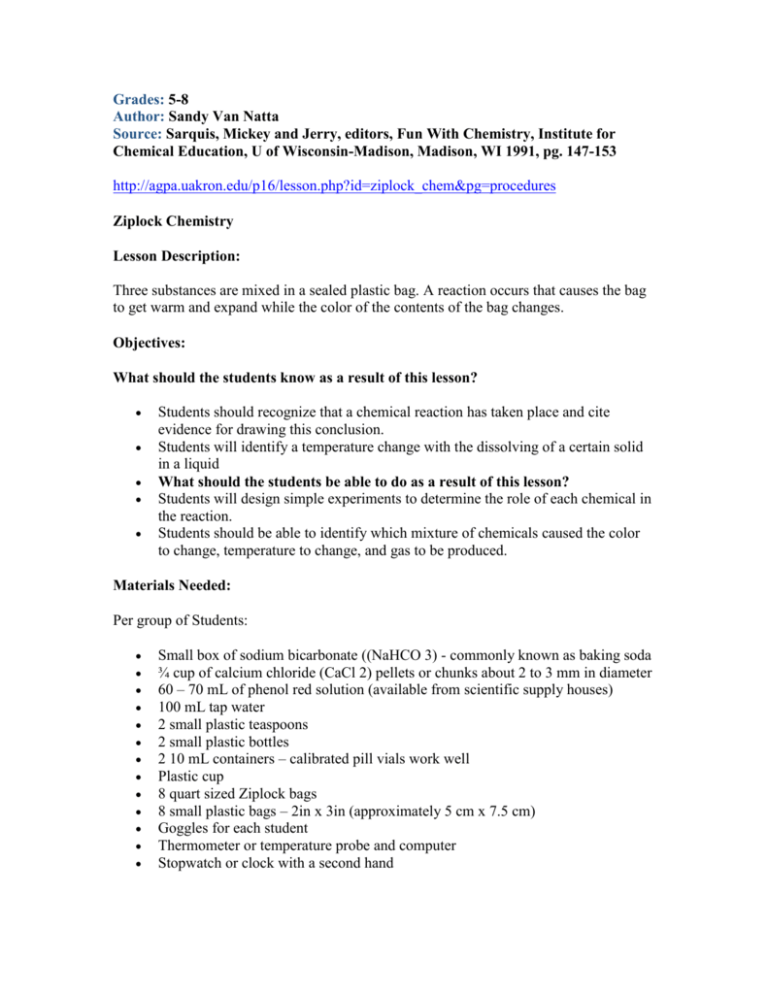
Grades: 5-8 Author: Sandy Van Natta Source: Sarquis, Mickey and Jerry, editors, Fun With Chemistry, Institute for Chemical Education, U of Wisconsin-Madison, Madison, WI 1991, pg. 147-153 http://agpa.uakron.edu/p16/lesson.php?id=ziplock_chem&pg=procedures Ziplock Chemistry Lesson Description: Three substances are mixed in a sealed plastic bag. A reaction occurs that causes the bag to get warm and expand while the color of the contents of the bag changes. Objectives: What should the students know as a result of this lesson? Students should recognize that a chemical reaction has taken place and cite evidence for drawing this conclusion. Students will identify a temperature change with the dissolving of a certain solid in a liquid What should the students be able to do as a result of this lesson? Students will design simple experiments to determine the role of each chemical in the reaction. Students should be able to identify which mixture of chemicals caused the color to change, temperature to change, and gas to be produced. Materials Needed: Per group of Students: Small box of sodium bicarbonate ((NaHCO 3) - commonly known as baking soda ¾ cup of calcium chloride (CaCl 2) pellets or chunks about 2 to 3 mm in diameter 60 – 70 mL of phenol red solution (available from scientific supply houses) 100 mL tap water 2 small plastic teaspoons 2 small plastic bottles 2 10 mL containers – calibrated pill vials work well Plastic cup 8 quart sized Ziplock bags 8 small plastic bags – 2in x 3in (approximately 5 cm x 7.5 cm) Goggles for each student Thermometer or temperature probe and computer Stopwatch or clock with a second hand Getting Ready: 1. Label one spoon baking soda and the other sodium bicarbonate. 2. Measure 10 mL of water into one of the vials. Make a mark at the 10 mL level with a permanent marker. Repeat for each of the vials to be used. 3. If powdered phenol red solution is purchased, prepare a solution by mixing a peasized amount of phenol red powder in 2L of tap water. The solution should be cherry red. If the solution is orange or yellow, add a small amount of dilute basic solution such as ammonia or NaOH in water. 4. Place the phenol red solution in plastic bottles and label. Procedures: Engagement Before beginning, remind students to exercise safe practices in conducting the activities in this lesson. For Students: 1. Place 2 level teaspoons of calcium chloride (CaCl 2) and 1 level teaspoon of sodium bicarbonate (NaHCO 3) in a quart sized Ziplock bag and record observations after each addition. 2. Measure 10 mL of the phenol red solution in the marked plastic vial and pour it into the small plastic bag. 3. Place the small plastic bag upright inside the larger Ziplock bag. Carefully squeeze most of the air out of the Ziplock bag and seal it. 4. Spill the phenol red solution out of the small bag by tilting the sealed Ziplock bag. Mix the contents by squeezing the outside of the bag. If the bag becomes too full with a gas – open the bag to let some of the gas escape before the bag explodes! Record your observations. For the Teacher: Discuss the students' observations with the class. Students should have noted a temperature increase, a color change from red to yellow, and the filling of the bag with a gas. A few students may have also noted a temporary temperature decrease. Ask the students what they think is happening in the bag. Assessment: Assessment is informal at this stage. Make sure all students are following the proper procedure and contributing to the discussion. Make sure they are recording their observations on their worksheets. Exploration Challenge the students to design additional experiments to determine the combination of chemicals responsible for each change that occurred. Remind them not to change the amount of each chemical used. Tell them that the phenol red solution was made by mixing phenol red powder in water. Water can be substituted for phenol red in some of the experiments. The following experiments might be tried: Mixing calcium chloride with phenol red solution Mixing calcium chloride with water Mixing sodium bicarbonate and phenol red solution Mixing sodium bicarbonate and water Mixing sodium bicarbonate, calcium chloride, and water Students should record their observations after each experiment. Assessment: Again, see that students are following proper laboratory procedures. Monitor the groups and make sure they are recording their observations. Explanation Have students report their findings. Ask the students what evidence they might have that a chemical reaction took place in the bag. They can cite the production of a gas (the bag expanded), a change in temperature, and a change in color. Point out that these things MAY indicate a change has taken place. Any of these observations alone may represent something else. Discuss with students, what components they think were responsible for each of their observations. Use only as much of the following information as you think is appropriate for your students. The solution gets warm because heat is given off when calcium chloride dissolves in water (not a chemical reaction). This process is exothermic. When sodium bicarbonate dissolves in water, heat is absorbed and the solution gets colder. This process is endothermic. In the first experiment, students may not have felt this lowering of temperature since twice as much calcium chloride was used as the sodium bicarbonate. (If the two solids are not mixed well, some of the regions of the bag may feel cold.) The phenol red turns yellow when CO 2 produced dissolves in water to produce carbonic acid. Note: the addition of some solutes to a solvent will raise the temperature of a solution, while others will have no noticeable effect. This behavior depends on the heat of solution of the solute in a given solvent. The heat of solution, i.e., the amount of heat given off or absorbed during the process of solution, is equal to the difference between the energy that must be supplied to break up the crystals of the solute and the energy that is released when the solute particles are taken into solution by the solvent. If more energy is required to break up the crystals than is released in forming the solution, the temperature will decrease. If more energy is released in forming the solution than in breaking up the crystals, the temperature will increase. The following is for your information and may be too detailed for your students: The gas evolved is carbon dioxide. The bicarbonate ion (HCO3-) is a weak acid and partially ionizes in solution: HCO3- ↔ H+ + CO32The calcium ion (Ca2+) from the calcium chloride reacts with the carbonate ion (CO32-) to form insoluble calcium carbonate: Ca2+ + CO32- ↔ CaCO3 The hydrogen ions react with the bicarbonate ion to yield carbon dioxide: H+ + HCO3- ↔ H2O + CO2 The indicator changes colors because the carbon dioxide dissolves in water to produce an acidic solution. Phenol red is red in basic solutions and yellow in acidic solutions. CO2 + H2O ↔ H2CO3 ↔ H+ + HCO3Assessment: Collect and evaluate the students’ worksheets for completeness and accuracy. Elaboration In this stage, students determine the amount of temperature change in the exothermic and endothermic processes. 1. Place 2 teaspoons of calcium chloride in a Ziplock bag. Place a thermometer in the bag so that it is touching the calcium chloride. Read and record the initial temperature of the calcium chloride. 2. Add 10 mL of water to the bag and seal the bag so that the end of the thermometer is sticking out. 3. Use a stopwatch or wall clock and record the temperature in the bag, every minute for at least 5 minutes. 4. Rinse the thermometer off and dry it. 5. Repeat steps 1 – 4 using 2 teaspoons of baking soda instead of calcium chloride. 6. Graph the data obtained for each material. Identify the independent variable and place it on the X-axis. Identify and place the dependent variable on the Y-axis. 7. Tell what happens to the temperature of the contents of each bag and whether it is an exothermic or endothermic process. Try to explain what may be happening if there are any changes to the slope of your graph. Note: If a temperature probe and computer are available, use the probe to record the temperature changes and have the computer graph the data. Many more data points can be taken if a temperature probe is used. Time should be placed on the X-axis and temperature on the Y-axis. Assessment: Collect and evaluate student graphs as well as their answers to questions asked in Step 6.

